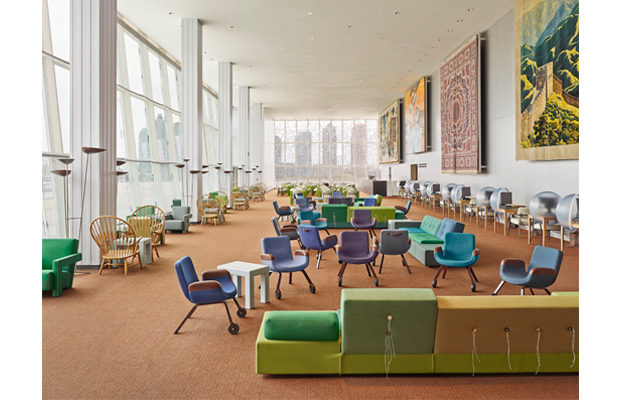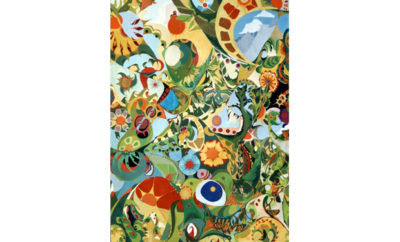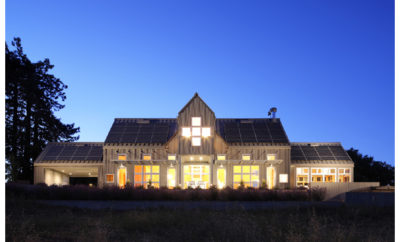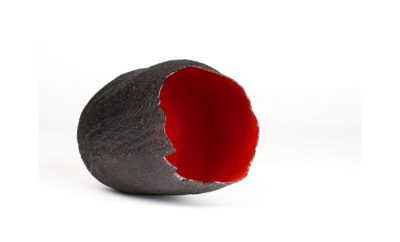
Feature
FLYING COLORS

In 2013 Hella Jongerius and Jongeriuslab undertook a top-to-bottom redesign of KLM Royal Dutch Airlines’ business class cabins, creating a unified aesthetic and rethinking everything from the construction of the seats to travelers’ onboard experience.
Hella Jongerius is one of the most influential designers at work today. Here in conversation with Sarah A. Lichtman, she discusses her thoughts on color and her collaboration with KLM Airlines.
DUTCH INDUSTRIAL DESIGNER HELLA JONGERIUS works across a variety of mediums using seemingly contradictory approaches that have won her international acclaim. Whether made for limited or mass production, Jongerius’s work, including interiors, products, textiles, and ceramics, unites craft and industry, employs high and low tech, and draws on rich historical contexts to produce startlingly contemporary pieces. A graduate of the renowned Eindhoven Design Academy, an incubator in the early 1990s for new Dutch design, Jongerius participated in the first Droog exhibition, at the Milan Furniture Fair in 1993, and went on to establish her own design studio, Jongeriuslab. Clients include IKEA, Vitra, Royal Tichelaar Makkum, Maharam, and KLM Royal Dutch Airlines, whose business class cabins she extensively redesigned in 2013. In the same year she completed a commission for the Netherlands’ Ministry of Foreign Affairs to form and lead a team of designers to redesign the United Nations North Delegates’ Lounge.
In some of her designs, Jongerius draws inspiration from Dutch history and culture. For example, her porcelain Delft Blue B-Set translates traditional Dutch decoration into contemporary expression, while her hanging Flower Pyramid imaginatively reinterprets a seventeenth-century Dutch object in the Rijksmuseum. Jongerius’s work has been exhibited at the Museum of Modern Art in New York, the Design Museum (London), the Stedelijk Museum (Amsterdam), and other well-known institutions. In April 2015 Jongerius and design theorist Louise Schouwenberg issued Beyond the New: A Search for Ideals in Design, an idealistic, multipoint manifesto that deplored what they deemed to be designers’ “obsession” with the new for its own sake. Jongerius and Schouwenberg also lamented designers’ loss of values and called for a holistic approach that would refocus and reinvigorate the profession.

Jongerius’s design for the North Delegates’ Lounge (2013) was part of a large-scale renovation of the United Nations headquarters. Jongerius paired some of the lounge’s existing furnishings, including Hans Wegner 1947 Peacock chairs, with Jongeriuslab designs, such as the Polder sofa. She also designed several pieces for the space, including a table and a chair—the UN Lounge chair produced by Vitra—carpeting, and a curtain of porcelain beads for the south window. Photo by Frank Oudeman.
Sarah Lichtman: Much of your work celebrates color and also challenges our ideas of how color can be used in industrial as well as limited-production objects. In Coloured Vases (series 3), for example, a project produced in collaboration with the porcelain brand Royal Tichelaar Makkum in 2010, you experimented with synthetic, natural, and even historical color recipes that required considerable archival research.
Hella Jongerius:Yes,the work I do with color is a kind of unfinished research project. It will never be finished but I’m very happy because I can go on forever!
SL: What other types of research do you do that influence your color sensibility?
HJ: Well, sometimes I paint. The pigments are so much richer. I recently did this painting group just to have a sense of what happens with color and light. But I also do other types of research. I have these light boxes in my studio where you can measure the daylight and then see how the shadows change. My work with color has many, many layers.

The 2008 Flower Pyramid, also produced by Royal Tichelaar Makkum, was inspired by a seventeenth-century example in the Rijksmuseum in Amsterdam.
SL:What motivates you most in your work with color?
HJ: I want to change the industrial color field. In the entire world there are only a few large companies that are producing pigments. We as designers have to work with these pigments, with these recipes, and they are quite limited. The colors they produce are stable and keep the color consistent in different light conditions throughout the day.
SL: Why is that a problem?
HJ: Because a color is about reacting to the daylight. I would like to see a much broader and much richer array of paints and pigments that we can use as designers in our plastics and in all the lacquers that we use for metal and wood. I want to have this richness that we know from art and from nature and from the world.
SL: You once said that a single color is not a color at all; instead, colors exist when they are in concert together.
HJ: Yes, color is in so many elements, so you need to know what each surface brings to another color. You see colors reacting with one another in a collection, and the colors change with the light. I recently started researching color and three-dimensional shapes, as well as the huge topic of color and space. It has so many angles, this color thing.

For Coloured Vases (series 3) (2010), Jongerius combined historical mineral recipes with industrial color transfers to explore the perception of overlapping hues. The Vases fabric by Maharam was inspired by these experiments. Photo by Gerrit Schreurs.
SL: How do different materials affect the ways colors interact?
HJ: Take textiles for example. In textiles, how colors mix is the result of differing yarn constructions, in cotton or wool, or in a gloss. So there are so many options that we have as designers. But, honestly, I don’t really see anybody researching it. In some of the other industries they don’t seem to care at all. What they do care about is having millions of options in colors, but they don’t come with real research or new ways of treating their recipes. Their decisions are mostly economic rather than aesthetic ones. They ask questions like “Does it scratch easily?” or “How does the UV light affect it?” It’s always on this level. So I really am interested in exploring other qualities. For example, I am very interested to see if I can come up with colors in plastic objects that stay alive, that contain oxygen, so to speak. Industry is very conservative about using plastics because if you use molds and heat them, certain colors won’t stay stable.
SL: Really, why does that happen?
HJ: Well, they say the colors don’t hold fast, but I don’t believe it. So I want to know more about that; I see that the plastic suppliers for the aviation industry are further ahead in using colors.
SL: I’m surprised to hear that because the aviation industry can be a conservative business.
HJ: Well, it’s not that they use colors as much as it is that they have more options from which they can source colors than, say, the furniture industry. The car industry is also much further ahead in colors—although they don’t use all the colors available—especially in terms of developing and researching this topic.
SL: Why do you think that is?
HJ: Because there is money being made in the aviation and auto industries and there is not as much money being made in furniture. In furniture, I think they think everybody is satisfied with a black office chair— a practical black plastic office chair—and nobody cares what it looks like so the industry will never develop colors because they don’t think there will be any money to be made. So that’s why I like to dive into this topic. To see what the possibilities are.
SL: One of your most recent commissions was to redesign the business class cabin of KLM’s planes. What was it like working with the executives of such a large company? I don’t imagine that they talk to designers that much.
HJ: No, they never talk to designers! In a sense, though, we both were new to the process since they had never met a designer before, and I had never met a corporate company. It was strange at first, but there was a very good chemistry between us because the team I worked with was also young, and the senior boss had been working at KLM for many years, so he was kind of relaxed about the whole project. There was an atmosphere where we could do something that was a bit different. Everybody wanted to have something new.
SL: In your work, decoration can function as a bridge between the user and the object. A business like KLM, like all businesses, is concerned with the bottom line. Was it difficult to convince them of the importance of spending money on decoration— something that’s hard to quantify?
HJ: Yes, a corporation like KLM is not used to decoration in an airplane cabin. When I proposed using my dots in the cabin upholstery, I had a difficult time coming up with a reason why we needed to have decoration. With a corporate client, you can’t always say, “because it’s beautiful” or “people like it.” You have to come with a more functional reason. But I found a reason for the dots and think it really works! I used small dots in the cabin to give the effect of sparkling little elements that bring in some poetics; they can be interpreted as stars in the galaxy. I used larger dots when I designed the cabin curtain. I do a lot with dots in other designs, so it’s become my signature. I used dots when I created the Knots & Beads curtain in the Delegates’ Lounge of the United Nations. The decoration really softens the space.

The Knots & Beads curtain for the North Delegates’ Lounge, fabricated by one of the Netherlands’ oldest companies, Royal Tichelaar Makkum, is composed of thirty-thousand semi-glazed porcelain beads suspended on hand-knotted yarn. Oudeman photo.
SL: In addition to the textiles and interior fittings for the cabin, you also designed the seats. Was that part of the original design plan?
HJ: When KLM visited my studio, they asked me if I wanted to do the seat covers and then told me I had six weeks. The seat itself was not part of the commission at that point. I said yes of course I can do the covers, but I thought to myself, “I have no idea!” But I have a lot of experience in textiles, so I said I just need to know what the constraints are and then I can work it out. Along the way KLM and I got to know each other. I knew there was a commission for the redesign of the seat coming up and since I already knew the cabin well, I asked KLM who they’d chosen to design the seat. They said, “Oh, nobody; we just buy it from the manufacturer and let the technical engineers give them a KLM tweak.” So I said,“No! Come on! We can do so much better.”
SL: This must have been very late in the redesign process?
HJ: Yes, we were so late and we didn’t really have time, but we thought, “Come on, let’s give it a try.” So I started to design the chair and with it the whole cabin, including the loose items and the bulkheads. It became a large project, so it was not done in six weeks! We worked with a very small team—I only dealt with two other designers—and I think we worked almost non- stop on the job for two years. There was a lot of trust and a lot of meetings. It was never like I delivered an idea to KLM and they just said “yes” or “no.”

Each passenger’s personal space is delineated by the seat’s armrests, screen, and headrest, which is revealed to be KLM Blue when the seat is extended.
SL: Were there any miscommunications?
HJ: Well, I started to design the yarns for the seat cover but the executives never understood that it takes time. And if you dye your color, it also takes time. And if you then start to weave, you have to do the testing and all that. They thought we came from another planet! And of course a lot of ideas fell off the table because we were sometimes far, far ahead in our thinking, and perhaps too nerdish about design.
SL: In terms of color and pattern?
HJ: Well, we wanted to have things that were too
conceptual. For example, we had an idea for the car- pet that was too far out for them. A challenge with airline carpets is that as soon as a spot appears— which happens a lot—the airline repairs it by cutting out the dirty spot. So I had to design a carpet with a pattern that made it easy to repair while leaving few visible seams. I thought, “Why don’t we design some- thing that is really nice even when it has spots?” But they couldn’t understand the concept of a carpet whose design could grow over time and they thought everybody would see this and think the plane was dirtier than others, you know? But I must say KLM was very open, and I really could achieve a lot.

SL: There must have been a tremendous number of regulations to consider in designing for the aviation industry.
HJ: Yes, there were many rules and also many constraints from the providers like Boeing and Airbus. It is a monopolistic market so they come with all the rules and regulations. In a way, they have a set of rules so that you can’t use any new materials. For example, as soon as you glue fabric on existing materials—or whatever—it’s considered a new material, which then has to go through industry testing. And to start testing a new material takes a year and costs a lot of money so nobody wants to start the process. So, surprisingly, we were really restricted by the suppliers and not by the client itself. KLM was open for a lot of things.
SL: Can you tell me some things that KLM was open about?
HJ: For example, we came up with five subtly different, but complementary, colors for seat covers, but such variety has an enormous impact on production logistics. But everyone liked it, and we all were in agreement that we wanted to make the extra effort to produce five colors. Through such variations in color you can really create your own personal space—an individual throne; my space; your space; all of it is really defined because you have your own seat color. So everybody liked the idea very much and then it went to the group of directors, and they said, “Why don’t we do three instead of five?” And I explained to them that three is nothing; if you put three in the plane, it won’t have an effect. It looks like a mistake, it doesn’t look like a design. But now we are doing a new plane, a 787, and we talked again about the seat covers, and I was the first one to say, “Listen guys, you know, I like it very much that we have five seat covers, but if you now want to change it to three, I can live with it. But everyone at KLM said, “No way! We will stick to the five.” So, you know, the design is something that they believe in. It’s not only a marketing trick in the end.
SL: So at the end of the day, it seems like both the designer and client were satisfied with the collaboration?
HJ: Yes, once we started doing the new seat, I realized how much we learned from each other—designers and clients. It was a really interesting partnership and really interesting to learn to get along.
SL: What do you think the impact of your KLM project will be on future aviation design?
HJ: I see my designs for KLM as a moment in time. Now we have designed this interior, but in ten years we can do something totally different because the aviation industry will change. In thinking about the design of the seat, for ex- ample, if you were to take out the fixed monitors and give everybody a laptop, then the furniture would look totally different. With these changes all of the conservative rules from the suppliers will not be possible. I predict that soon a new design revolution will come. Aviation is a very fast-moving industry so I have hope. Maybe the changes might happen later; but I have only just started.












